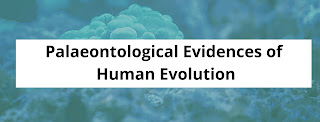Describe in brief the palaeontological evidences of human evolution.
Describe in brief the palaeontological evidences of human evolution.
Answer : The study of human evolution is based on fossil records. Fossil bones of human ancestors are discovered from Africa, Germany, France, China, Java and other parts of Asia. The available fossils are skulls, mandibles, teeth, bones like humerus, femur and stone implements. The fossils belong to different geological ages which are given different names.
Fossil records in the line of human evolution are not quite adequate. However, four main stages in the origin of man were understood from paleontological evidences, viz. ape-stage, apeman stage, primitive man, prehistoric man and modern man.
i) Ape-stage: Primitive apes which lived 30 million years ago probably gave rise to man. The primitive ancestral apes propliopithecus
might be the ancestor of modern apes and man. Propliopithecus gave rise to
Dryopithecus. All these apes are found in fossilized form.
ii) Ape-man stage: The stage intermediate between ape and man is called ape-man stage. The important ape-men are Ramapithecus Kenyapithecus Australopithecus. Australopithecus is an important fossil as it was the connecting link between apes and primitive men.
iii) Primitive man (prehistoric man) : The primitive man was the first true man. The following are the important primitive men or prehistoric men obtained as paleontological Evidences:
1) Homo habilis (Handy man)
2) Homo erectus Java man and Peking man
3) Homo heidelbergensis (Heidelberg man)
4) Homo neanderthalensis (Neanderthal man)
iv) Modern Man: Cro-Magnon man called Homo sapiens fossilis was the extinct modern man. The fossil of this man was obtained from France.
Write a note on Palaeontological evidences.
Answer :
- Palaeontology is study of fossils
- Fossils are defined as the dead remains of plants and animals that lived in the past in various geological layers. Evidences from fossils are sound, direct and reliable.
- fossils are the true witnesses or documents of evolution.
- During fossilization the primitive formns of organisms occupy the lower layers and the advanced forms occupy the upper layers of the earth.
- Fossils are formed in sedimentary rocks, amber, volcanic gas, ice, peat bogs and soil etc.
- Fossils may be Actual remains, Moulds and Casts.
- Palaeontological evidences is useful in reconstructing the phylogeny, helps in studying various other forms and structure of extinct animals their habit.

